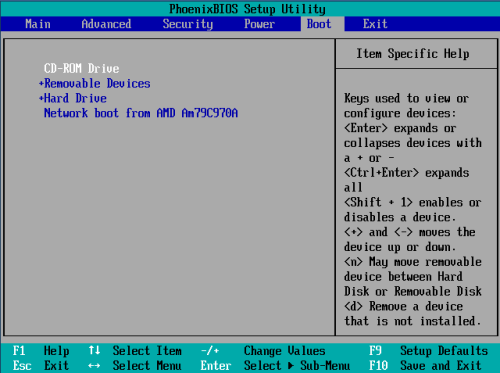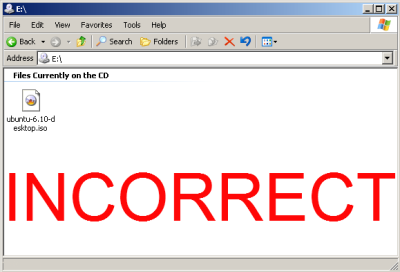- 1
BootFromCD
- A common power-on BIOS screen(notice the 'press DEL for setup' message)
- A typical BIOS boot menu screen

- Apple Computers and others: Hold down the C key while rebooting. Toshiba, IBM and others: press F12 while booting to get to the boot menu and choose CD-ROM. Asus and others: press TAB key while booting and select CD-ROM from boot menu.
Multiple CD/DVD drives in your computer
BIOS does not have the option of booting from CD/DVD drive
CD drive not capable of booting a CD (older drives)
- Purchase or borrow a newer CD-ROM drive.
- Press F6 for "Other Options." Try to apply boot parameters:
Using a USB drive?
- 2
- We recommend you plug your computer into a power source
- You should also make sure you have enough space on your computer to install Ubuntu
- We advise you to select Download updates while installing and Install this third-party software now
- You should also stay connected to the internet so you can get the latest updates while you install Ubuntu
- If you’re not connected to the internet, we’ll help you set up wireless at the next step
- 3
- 4
- 5
- 6
- 7
- 8
- 9
- 10
the system installs…
- 11
- It’s easy to install Ubuntu from a DVD. Here’s what you need to do:Put the Ubuntu DVD into the DVD-driveRestart your computer. You should see a welcome screen prompting you to choose your language and giving you the option to install Ubuntu or try it from the DVD.If you don’t get this menu, read the booting from the DVDguide for more information.
Check and make sure that the disk was burned properly. If you bought an original CD from a (web) store, then you should not have to worry about this section. If you have not yet burned the downloaded ISO image from the Official Ubuntu Download Page to a disk, then head on over toBurningIsoHowto for directions.
In your current operating system when you navigate the CD that you burned, you should see multiple directories and files, not the single .iso file. If you see just the single .iso file when browsing to the CD, it has been improperly burned and you will have to burn it again following the instructions atBurningIsoHowto.
- Incorrect CD file display. You will have to burn it again following the following instructions at BurningIsoHowto.
Some computers are set to boot directly from the hard drive. This should be as simple as entering the BIOS, enable booting from the CD-ROM drive, and making sure that the CD-ROM is before the hard drive in the boot order.
The most common way to enter the BIOS is to press the DELETE key when the computer is first booted(this seems to be becoming standard). On other systems it could be a different key, or combination of keys like ESC, F1, F2, F10, F12, Ctrl-Esc, Alt-Esc, Ctrl-Alt-Esc, Ctrl-Alt-Enter, Ins or even others. You might have to press, press and hold, or press multiple times. The best way to find out the details of that is to look in the users manual or search the manufactures website. A few different Bios screens.
Some computers require you to hold down or press a key to enable booting from the CD drive, the best place to find this information is in your computers user manual or the manufactures website. Here are some common keys to try if you lack that information.
A large number of CD/DVD drives have problems running under AHCI/Raid mode (from not working at all to refusing to boot).
Either plug drive into another SATA port that isn't set to AHCI/Raid or if that can't be done go into BIOS and set mode of SATA ports to IDE/Compatibility mode.
(WARNING: if your Boot drive is plugged into same group of ports it may fail to boot after change(and obviously any Raid arrays will fail also)).
Some computers will only allow booting from one CD or DVD drive even though you have 2 or more CD/DVD drives. So try the disk in each of the drives while rebooting the computer.
Some manufacturers provide BIOS updates that can correct this issue. For a BIOS update, please check with the manufacturer.
A workaround is available if you can read from your CD-ROM drive, but can not boot from it. You may be able to use the SmartBootManager on a floppy disk to force your computer to boot from the CD-ROM drive.
Some drives are just too old and do not support booting and will require you to:
- Use the SmartBootManager to boot from the CD-ROM drive.
If you have arrived at this prompt, you have successfully booted from the CD. But if you can not get any further, you may want to try some optional bootParameters to get you running.
If unfortunately none of these options worked for you, there are still other options. Please take a look at 'Installation without a CD' and 'Network Installations' on the Installation page.
Most newer computers can boot from USB. You should see a welcome screen prompting you to choose your language and giving you the option to install Ubuntu or try it from the CD.
If your computer doesn’t automatically do so, you might need to press the F12 key to bring up the boot menu, but be careful not to hold it down - that can cause an error message.
- If you are not connected to the internet, you will be asked to select a wireless network, if available. We advise you to connect during the installation so we can ensure your machine is up to date. So, if you set up your wireless network at this point, it’s worth then clicking the Back button to go back to the last screen (Preparing to install Ubuntu) and ticking the box marked ’Download updates while installing’.
- Use the checkboxes to choose whether you’d like to Install Ubuntu alongside another operating system, delete your existing operating system and replace it with Ubuntu, or — if you’re an advanced user — choose the ’Something else’option
- Depending on your previous selections, you can now verify that you have chosen the way in which you would like to install Ubuntu. The installation process will begin when you click the Install Now button.Ubuntu needs about 4.5 GB to install, so add a few extra GB to allow for your files.Not sure about this step? Windows users can use the Windows installer, which will install and uninstall Ubuntu in the same way as any other Windows application. It’s simpler and completely safe.
- If you are connected to the internet, this should be done automatically. Check your location is correct and click’Forward’ to proceed. If you’re unsure of your time zone, type the name of the town you’re in or click on the map and we’ll help you find it.TIP: If you’re having problems connecting to the Internet, use the menu in the top-right-hand corner to select a network.
- Click on the language option you need. If you’re not sure, click the ’Detect Keyboard Layout’ button for help.
- …or make a cup of tea!
- All that’s left is to restart your computer and start enjoying Ubuntu!



